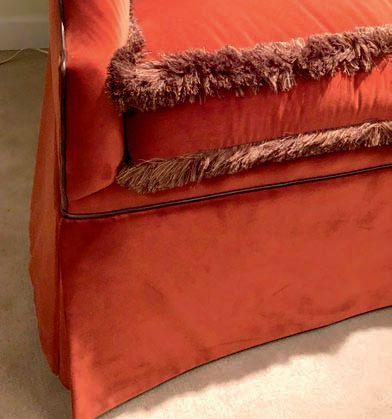
5 minute read
The Four Effs A look at the top embellishment trends from the



Fur Forward
Fur, in its many variations, showed up in unlikely combinations. This modern mix of materials called for a double take, for example, rabbit fur was paired with ceramic and mirror.
CLOCKWISE FROM TOP LEFT: The Monaco chair in Mongolian fur from Modshop. • The Gunma leather tray with rabbit fur lining, shown with Chaucer vases, all from Green Apple Home Style. • A lidded ceramic jar with a rabbit fur pom-pom, and the Andrade lamp with rabbit fur and tassel from also from Green Apple Home Style. Fun Fur Fact: Mongolian and Tibetan fur are both lambswool. Tibetan lambs’ silky fur can be 3–4" longer than Mongolian and both types of fur can be straightened if they start to frizz.





Fringed Fantasies
From suede, leather, ball chain, cotton, rayon, and even in performance yarns, fringe transforms these furnishings into conversation pieces. It spans the style spectrum from artisanal to glam depending on the “shag quotient” and fabrication.



TOP ROW FROM LEFT: The Elan/S Fringe chair from Nathan Anthony, uses black leather strips patched into a geometric tile design that cascade to an 18" drop from the seat bottom. • Shaggy leather chair in ombré leather from South African Ngala Trading. • An ivory bullion fringe sweeps while it swivels on the Mary Jane chair at Highland House. • The Hendrix ottoman with ball-chain fringe from Marge Carson features metallic welt and brass nail heads. CENTER ROW FROM LEFT: Justina Blakeney’s Fela tassel fringe chandelier at Selamat. • Corey Damen Jenkins’ uses an ultra- thick brush fringe as welting on his Camilla sofa at Leathercraft. • The Epaulette trefoil ottoman by Perennials Social at EJ Victor uses three layers of a short bullion fringe to create a skirt. Bonus is that the fringe is made of performance yarn. BOTTOM ROW FROM LEFT: Paula Queen of Pyar & Co. holding one of her new pillows. • Tailored leather fringe pillow from V Rugs & Home.




Jana Platina Phipps is well known as a trimmings designer with a refined vision for the use of trims in home furnishings, fashion, and luxury DIY. Affectionately called Trim Queen by her clients, she adopted the moniker and launched her blog “Trim Queen Chronicles” in 2013, and now shares inspiration of modern embellishment and creativity daily via her social media channels.
Want more? Jana will present “Translating Fashion into Design” at IWCE in Tampa. Sign up now at
iwce-vision.com.
TrimQueen.com Instagram: TrimQueen Twitter: @TrimQueen Pinterest: TrimQueen Facebook: TrimQueen

INSPIRE on our radar The
Is Urban Future
Exponential population growth equates to more city dwellers. And more city dwellers equate to radical changes in lifestyle, many of which are already underway, such as the seismic shift in transportation alternatives in major cities—bike sharing, car sharing, on-demand car services, etc. How urbanization will continue to shape the way we live, work, shop, and socialize is the basis of Heimtextil’s 2018/2019 trend presentation.
Taking a slightly different approach than previous years, FranklinTill Studio, which led the trend research team, developed four lifestyle trends—The Flexible Space, The Healthy Space, The Re-Made Space, and The Maker Space—and then developed five color and design themes that support these trends. While color trends always capture our attention, it’s really the lifestyle trends that are the longterm drivers of change. z












The Maker Space
The rapidly growing Maker Movement is bringing about a revolution in manufacturing. It has the potential to fundamentally change the nature of production, thanks largely to the democratization of digital fabrication technology, which allows anyone, anywhere, to create their own items.
Brands and manufacturers are getting wise to the demand for selfrealization through making. They are becoming educators, to satisfy the demand from those seeking new learning experiences. Cutting-edge technology and hands-on practical skills will offer connection to a community of like-minded individuals. Clockwise from top left: Kniterate raised more than $500,000 on Kickstarter for its compact digital knitting machine. Easy-to-use software is built on a platform that encourages creators to share and co-develop customized designs. • In her most recent work, London-based Lola Lely combines combines Japanese shibori techniques with home-made pigments procured from all natural resources. • A Factory As It Might Be by Studio Assemble created the tiles on-site as it finished the façade of its temporary factory. • Post Couture Collective allows customers to download, customize, manufacture, and self-assemble clothing designs. The laser-cut pieces require no stitching. Instead they are slotted together using interlocking seams. Designs can also be downloaded as CAD files for DIY production in any suitable material. • Unmade is a platform that allows consumers to customize clothing items, with orders being sent directly to factories for seamless integration into existing production. • Founded by Martta Leskelä, an economist and entrepreneur, Ragamuf is a socially centric design studio in Turkey that employs Syrian refugee women to hand knit “chair rugs” with rags from textile industry surplus, making each chair rug unique.










